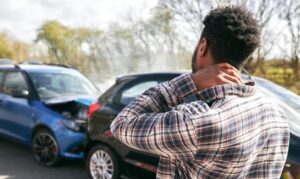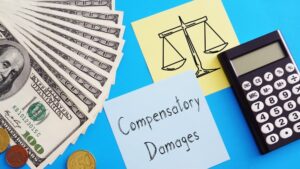Even though individuals are not supposed to operate a vehicle without insurance, that does not stop some uninsured drivers from getting behind the wheel of a car or truck. Obviously, this situation presents a serious problem when these drivers cause accidents that lead to injuries for others. If you suffered injuries in a motor vehicle accident that an uninsured motorist caused, an experienced car accident lawyer in your area can explore your legal options. In many situations, accident victims can turn to their own insurance company for compensation through an uninsured motorist claim. If you’re eligible to move forward with one of these claims, your attorney can handle every step of the process for you and work to obtain the settlement or litigation compensation you need for your injuries and losses.
Accidents that Lead to Injuries
 Car collisions can result in a range of debilitating injuries, each type presenting its own set of challenges for victims. Head-on collisions, where two vehicles collide frontally, are particularly notorious for causing severe injuries. These collisions can lead to severe head trauma, neck injuries, and chest injuries, often leaving occupants with long-lasting consequences that affect their daily lives.
Rear-end collisions are another prevalent type of car accident, often due to tailgating or sudden stops. Whiplash, a common injury in these situations, can cause persistent neck pain and discomfort. Additionally, occupants may suffer head injuries if their heads make contact with the steering wheel or dashboard during the collision.
Side-impact collisions, commonly known as T-bone accidents, happen when the front of one vehicle crashes into the side of another. These collisions frequently result in significant injuries, especially for occupants on the side of the vehicle that receives the impact. Trauma to the head, chest, and pelvis is common, and fractures and internal injuries are prevalent due to the limited protection on the sides of vehicles.
Rollover accidents involve a vehicle overturning onto its roof or side, often leading to a range of debilitating injuries. Head trauma, spinal cord injuries, and fractures are common in rollover incidents. The risk of occupants being ejected from the vehicle during a rollover further increases the potential for severe injuries.
Collisions involving pedestrians or cyclists present a different set of risks, with individuals lacking the protective structure of a vehicle. Such accidents can lead to fractures, head injuries, and internal injuries for those struck by a car.
Motorcycle accidents, characterized by the exposed nature of riders, can result in various injuries. Road rash, fractures, and more severe head and spinal injuries are common consequences of motorcycle collisions.
Single-vehicle accidents, such as collisions with fixed objects or rollovers, also contribute to debilitating injuries. Factors like speeding, drunk driving, or adverse weather conditions often play a role in these incidents.
Understanding the diversity of injuries resulting from different car collision scenarios underscores the importance of promoting safe driving practices and implementing effective safety measures to reduce the effect on individuals and communities alike.
Car collisions can result in a range of debilitating injuries, each type presenting its own set of challenges for victims. Head-on collisions, where two vehicles collide frontally, are particularly notorious for causing severe injuries. These collisions can lead to severe head trauma, neck injuries, and chest injuries, often leaving occupants with long-lasting consequences that affect their daily lives.
Rear-end collisions are another prevalent type of car accident, often due to tailgating or sudden stops. Whiplash, a common injury in these situations, can cause persistent neck pain and discomfort. Additionally, occupants may suffer head injuries if their heads make contact with the steering wheel or dashboard during the collision.
Side-impact collisions, commonly known as T-bone accidents, happen when the front of one vehicle crashes into the side of another. These collisions frequently result in significant injuries, especially for occupants on the side of the vehicle that receives the impact. Trauma to the head, chest, and pelvis is common, and fractures and internal injuries are prevalent due to the limited protection on the sides of vehicles.
Rollover accidents involve a vehicle overturning onto its roof or side, often leading to a range of debilitating injuries. Head trauma, spinal cord injuries, and fractures are common in rollover incidents. The risk of occupants being ejected from the vehicle during a rollover further increases the potential for severe injuries.
Collisions involving pedestrians or cyclists present a different set of risks, with individuals lacking the protective structure of a vehicle. Such accidents can lead to fractures, head injuries, and internal injuries for those struck by a car.
Motorcycle accidents, characterized by the exposed nature of riders, can result in various injuries. Road rash, fractures, and more severe head and spinal injuries are common consequences of motorcycle collisions.
Single-vehicle accidents, such as collisions with fixed objects or rollovers, also contribute to debilitating injuries. Factors like speeding, drunk driving, or adverse weather conditions often play a role in these incidents.
Understanding the diversity of injuries resulting from different car collision scenarios underscores the importance of promoting safe driving practices and implementing effective safety measures to reduce the effect on individuals and communities alike.
Proving that the Other Driver was Negligent for a Motor Vehicle Accident
Proving negligence on the part of another driver in a motor vehicle accident scenario is crucial to seeking compensation for damages. To establish negligence, one must typically demonstrate that the other driver failed to exercise reasonable care, directly contributing to the accident. Eyewitness accounts play a pivotal role in proving negligence. Statements from individuals who witnessed the accident can provide valuable perspectives on the events leading up to the collision. Their observations may highlight actions or behaviors of the other driver that suggest a lack of attentiveness, reckless driving, or violation of traffic rules. Photographic evidence is another powerful tool in establishing negligence. Clear and detailed photographs of the accident scene, vehicle damage, and road conditions can be tangible proof. These images can help reconstruct the sequence of events and demonstrate any visible signs of the other driver's negligence, such as skid marks or traffic signal violations. Police reports are official documents that often include an officer's assessment of fault in an accident. Obtaining a copy of the police report can provide a professional opinion on the cause of the collision, supporting your claim of the other driver's negligence. Expert testimony can also lend credibility to your case. Accident reconstruction specialists or automotive engineers can analyze the available evidence and offer their professional opinion on how the accident likely occurred. Their expertise can help establish a clear link between the other driver's actions and the resulting collision. Medical records become relevant in demonstrating the extent of injuries sustained due to the accident. These records connect the injuries directly to the incident and may emphasize the severity of the consequences resulting from the other driver's negligent behavior. Traffic violations and citations issued to the other driver can also be strong evidence of negligence. If the other driver received a ticket for speeding, running a red light, or any other traffic offense related to the accident, it strengthens the argument that their actions were a direct cause of the collision. Witness statements, photographic evidence, police reports, expert testimony, and traffic citations collectively form a comprehensive case for proving another driver's negligence in a car accident. By gathering and presenting this evidence – and retaining experienced legal counsel for representation – you increase your chances of successfully demonstrating the other party's responsibility for the collision and securing the monetary compensation you deserve.Filing a Third-party Claim with the Responsible Driver's Insurance Company (if They Have Insurance Coverage)
If the at-fault driver has insurance coverage, a personal injury lawyer can file a claim for monetary damages with the at-fault driver’s insurance company. Filing a personal injury claim with the at-fault driver's insurer involves several key steps to ensure a smooth and comprehensive process. First, you should seek medical attention promptly for any injuries you sustained in the accident. Your health is a priority, and medical documentation will substantiate your claim. Once you've addressed your immediate health concerns, your attorney can gather relevant information about the accident. This includes the other driver's insurance information, contact details, and the police report. Additionally, your lawyer can collect any witness statements, photographs, or other evidence that supports your case. Next, your lawyer can promptly notify the at-fault driver's insurance company about your accident and provide basic information about the collision, including the date, time, and location. They may then prepare a settlement demand letter outlining the specifics of your personal injury claim. A demand letter will carefully detail the extent of your injuries, medical expenses, lost income, and any other damages incurred due to the accident. Your attorney can also attach supporting documents, such as medical bills, receipts, and records, to strengthen your case and clearly state the amount you seek in compensation. Your lawyer can then communicate openly with the insurance company adjuster assigned to your case. Insurance companies frequently attempt to settle for a low amount, so be prepared to present a strong case for the compensation you believe is fair. If the parties settle, they will then sign a formal agreement. However, if negotiations prove unsuccessful, you may consider mediation or alternative dispute resolution (ADR) methods. These approaches can facilitate a resolution without resorting to a lengthy court process. An experienced personal injury attorney can provide legal advice, assess the strength of your case, and guide you through the formal legal proceedings, if necessary.What if the At-fault Driver Doesn't Have Any Insurance Coverage?
Dealing with an at-fault driver who lacks insurance coverage adds an additional layer of complexity to the aftermath of a car accident. If you find yourself in this situation, taking the following steps can help you navigate the challenges:- Check Your Own Insurance Coverage – Review your own insurance policy to see if you have uninsured/underinsured motorist coverage (UM/UIM). This coverage protects you when the at-fault driver is uninsured or doesn't have sufficient insurance to cover your accident-related losses and damages.
- Report the Car Accident to Your Insurance Company – Regardless of the at-fault driver's insurance status, it is still important that you report the accident to your own insurance company as soon as possible. Provide them with all the details and any evidence you have. This ensures the claims process begins and your insurance company can assess the situation.
- Carefully Document the Car Accident – Collect as much evidence as possible. Take photos of the accident scene, vehicle damage, and any injuries you suffered. Gather witness statements and contact information. This documentation will be crucial in supporting your personal injury claim or lawsuit.
- Cooperate Fully with Your Insurance Company – Work closely with your insurance company throughout the claims process. Provide them with all necessary information, including medical records, expenses, and other written documentation related to your car accident.
- File a Lawsuit if Necessary – If your accident-related damages exceed the coverage limits of your insurance policy – or if you don't have UM/UIM coverage – you may consider filing a lawsuit against the at-fault driver. However, remember that collecting from an uninsured individual can be extremely challenging even if you obtain a judgment against the driver.
- Explore Other Legal Avenues of Recovery – In some cases, you may explore other avenues for compensation, such as looking into the at-fault driver's personal assets. However, this can also be challenging, and your recovery may be limited.
Available Monetary Damages
 Injuries sustained in a car crash can result in various types of monetary damages, encompassing both immediate and long-term financial implications. One primary category is medical expenses, covering the costs of both past and anticipated emergency care, hospitalization, rehabilitation, doctor and physical therapy visits, procedures, and medication. These expenses extend beyond the immediate aftermath of the accident and often accumulate as the injured party continues to receive medical attention.
Lost income and earning capacity represent another significant component of monetary damages. A car crash injury may lead to temporary or permanent disability, preventing individuals from working and earning income. Compensation seeks to address not only the income the injured accident victim lost during their recovery, but also their potentially diminished future earnings resulting from the accident-related injuries.
Pain and suffering damages account for the physical and emotional distress the accident victim experienced due to their car-crash injuries. It encompasses not only the immediate pain they experienced but also the long-term effects, emotional anguish, and effect on their overall quality of life. Quantifying pain and suffering is subjective and often requires the experience of legal professionals to present a comprehensive case for compensation.
Property damage constitutes another form of monetary damages resulting from a car crash. This includes the repair or replacement costs for the damaged vehicle and any personal belongings. Property damage can extend to other items affected in the accident, such as personal items, electronics, or valuables.
In some cases, car crash injuries can lead to loss of consortium, affecting the accident victim’s relationships and companionship with family members. Spouses or partners may seek compensation for the effect the injuries have on the dynamics of their relationships.
While less common, punitive damages may be applicable in cases of extreme negligence or intentional misconduct. These damages aim to punish the at-fault party and deter similar behavior in the future.
Navigating the complexities of these various monetary damages requires a comprehensive understanding of personal injury law. Seeking legal counsel can help injured parties assess the full extent of their damages and build a strong case for fair compensation that accounts for both the tangible and intangible consequences of car crash injuries.
Injuries sustained in a car crash can result in various types of monetary damages, encompassing both immediate and long-term financial implications. One primary category is medical expenses, covering the costs of both past and anticipated emergency care, hospitalization, rehabilitation, doctor and physical therapy visits, procedures, and medication. These expenses extend beyond the immediate aftermath of the accident and often accumulate as the injured party continues to receive medical attention.
Lost income and earning capacity represent another significant component of monetary damages. A car crash injury may lead to temporary or permanent disability, preventing individuals from working and earning income. Compensation seeks to address not only the income the injured accident victim lost during their recovery, but also their potentially diminished future earnings resulting from the accident-related injuries.
Pain and suffering damages account for the physical and emotional distress the accident victim experienced due to their car-crash injuries. It encompasses not only the immediate pain they experienced but also the long-term effects, emotional anguish, and effect on their overall quality of life. Quantifying pain and suffering is subjective and often requires the experience of legal professionals to present a comprehensive case for compensation.
Property damage constitutes another form of monetary damages resulting from a car crash. This includes the repair or replacement costs for the damaged vehicle and any personal belongings. Property damage can extend to other items affected in the accident, such as personal items, electronics, or valuables.
In some cases, car crash injuries can lead to loss of consortium, affecting the accident victim’s relationships and companionship with family members. Spouses or partners may seek compensation for the effect the injuries have on the dynamics of their relationships.
While less common, punitive damages may be applicable in cases of extreme negligence or intentional misconduct. These damages aim to punish the at-fault party and deter similar behavior in the future.
Navigating the complexities of these various monetary damages requires a comprehensive understanding of personal injury law. Seeking legal counsel can help injured parties assess the full extent of their damages and build a strong case for fair compensation that accounts for both the tangible and intangible consequences of car crash injuries.
Speak with a Car Accident Lawyer in Your Area Right Away

